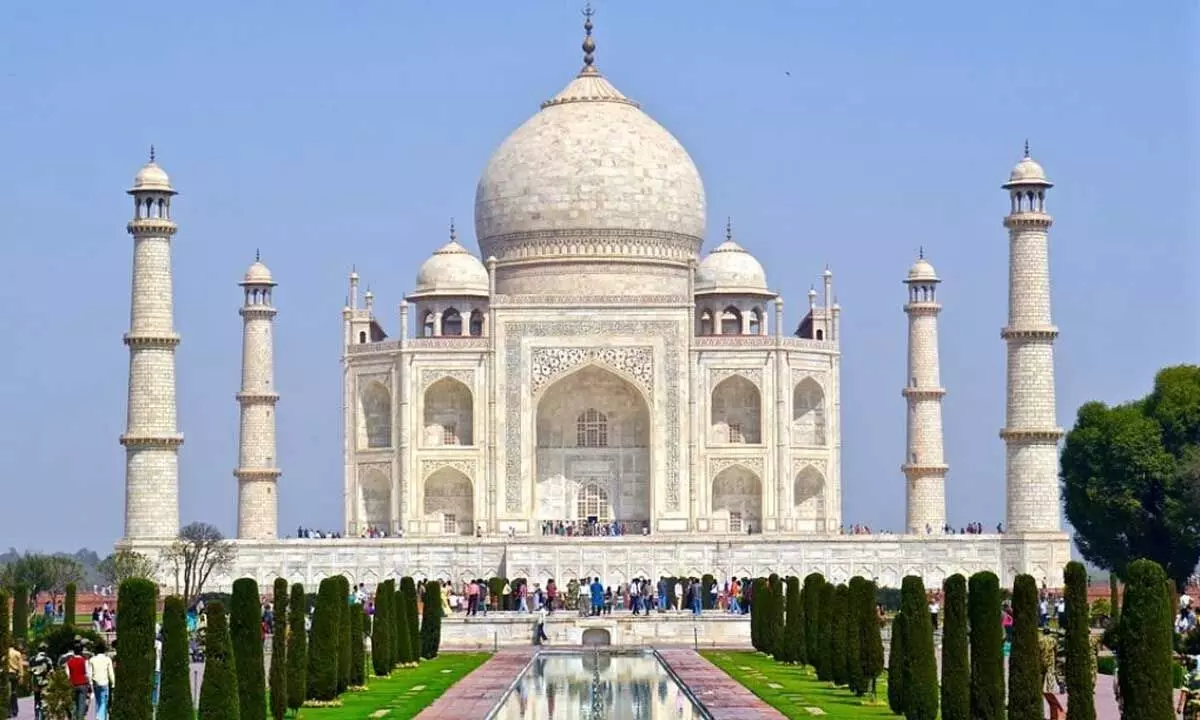Live
- They always want me to win, and now I feel lucky to have been offered a story like ‘Zebra’: Satyadev Kancharana
- ‘Democracy first, humanity first’: PM Modi in Guyana's parliament on two countries' similarities
- PKL Season 11: Telugu Titans register third straight win to top standings
- Is Pollution Contributing to Your COPD?
- NASA Unveils Underwater Robots for Exploring Jupiter's Moons
- Additional Central forces arrive in violence-hit Manipur
- AR Rahman and Saira Banu’s Divorce: Legal Insights into Common Issues in Bollywood Marriages
- 82.7 pc work completed in HPCL Rajasthan Refinery area: official
- Curfew relaxation extended in 5 Manipur districts on Friday
- Tab scam prompts Bengal govt to adopt caution over fund disbursement
Just In
Decide representation on alleged wrong historical facts related to construction of Taj Mahal: Delhi HC to ASI

Taj Mahal
The Delhi High Court on Friday asked the Archaeological Survey of India (ASI) to decide on the representation given by Surjit Singh Yadav, the president of the NGO Hindu Sena, seeking the removal of what is claimed to be “wrong historical facts” related to the construction of the Taj Mahal by Shah Jahan from history books used in schools and colleges.
New Delhi: The Delhi High Court on Friday asked the Archaeological Survey of India (ASI) to decide on the representation given by Surjit Singh Yadav, the president of the NGO Hindu Sena, seeking the removal of what is claimed to be “wrong historical facts” related to the construction of the Taj Mahal by Shah Jahan from history books used in schools and colleges.
A Division Bench of Chief Justice Satish Chandra Sharma and Justice Tushar Rao Gedela disposed of a Public Interest Litigation (PIL).
On January 7, Yadav had given a representation to the ASI after the Supreme Court had refused to entertain his petition seeking directions to the ASI to determine the "correct age" of the Taj Mahal and to remove "wrong facts" from history books regarding the monument.
However, he had withdrawn the petition while proposing that he would be submitting a representation to the ASI.
Before the High Court, he had urged, “To issue writ of mandamus commanding the respondents to remove wrong historical facts related to construction of Taj Mahal by Shah Jahan from history books and text books referred in the schools, colleges, universities and other institutions."
He had sought the court’s direction to the respondent to bring in public domain the alleged correct historical facts relating to the existence of the palace of Raja Man Singh on the land where Taj Mahal exists and also to incorporate the alleged correct historical fact that “Shah Jahan never constructed the Taj Mahal and only carried out the renovation of the palace of Raja Man Singh.”
He had argued that there was no historical evidence supporting the demolition of Raja Man Singh's palace and the subsequent construction of the Taj Mahal on the same site.
The PIL by Yadav sought a court direction to the ASI to investigate the age of the Taj Mahal and the existence of Raja Man Singh's palace as of December 31, 1631, and to submit a report to the court.
“To issue direction to the Archeological Survey of India to carry out investigation about the age of Taj Mahal including existence of palace of Raja Man Singh… on the site of Taj Mahal, in Agra and to file a report before this Hon'ble Court,” the petition said.
Furthermore, the petitioner had requested that the Central Government publish the correct history of Raja Man Singh's palace, which was allegedly renovated by Shah Jahan between 1632 and 1638, citing the book ‘Padshahnamah’ authored by Abdul Hamid Lahori and Qazwini.
“... to publish the correct history of the palace of Raja Man Singh (which had been renovated by Shah Jahan w.e.f. 1632 to 1638) and these facts can be culled out from the book namely Padshahnamah authored by court chroniclers historian Abdul Hamid Lahori and Qazwini respectively,” the PIL said.
Yadav claimed that the information presented in the plea is derived from public records, RTI applications, websites, and historical books.
The plea argued that people have a right to know the true historical facts about the construction of the Taj Mahal, and any non-disclosure or dissemination of incorrect information would violate Article 21 and Article 19(1)(a) of the Indian Constitution.
The petitioner also disputed the information provided by the ASI on its website, asserting that it took approximately 17 years to complete the Taj Mahal in 1648, while claiming that the Tomb of Mumtaz Mahal was nearly complete by 1638.
Therefore, the PIL contended that the commonly propagated historical fact about the 17-year construction period of the Taj Mahal is factually incorrect.
The respondents in the PIL included the Central Government, the ASI, the National Archives of India, and the State of Uttar Pradesh.

© 2024 Hyderabad Media House Limited/The Hans India. All rights reserved. Powered by hocalwire.com






